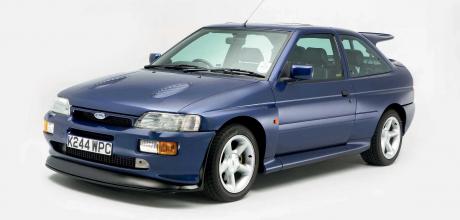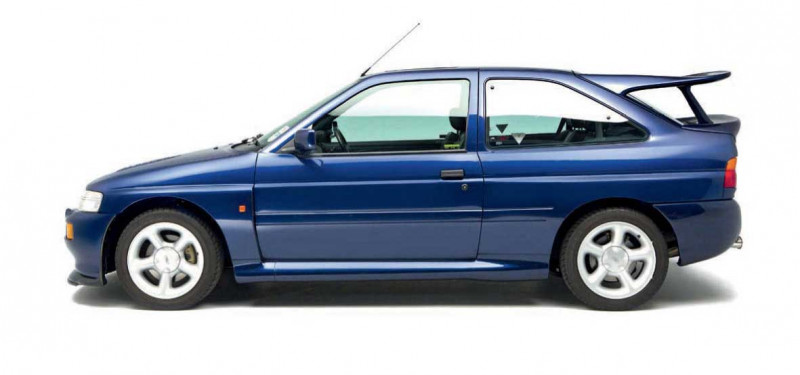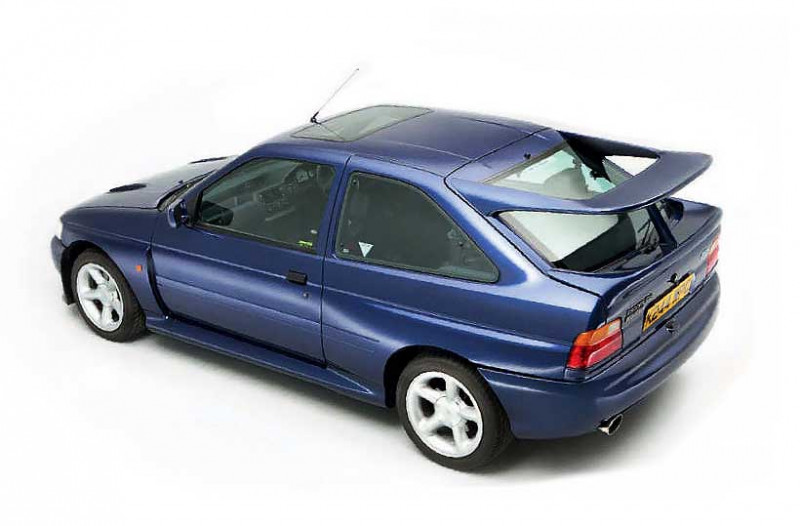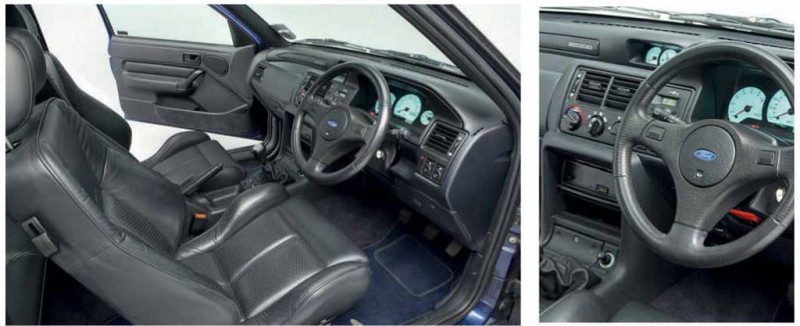Buyer’s guide Ford Escort RS Cosworth Mk5

The road and rally legend created a storm when it was launched in 1992 and 31 years on, its status has only grown — as have the values. Here’s what you need to know if you’re in the market for one.
Words Christian Tilbury
Photos Magic Car Pics
BUYING GUIDE: Escort Cosworth — What to check when buying Ford’s performance icon.

“YOU DIDN’T EVEN NEED TO SCRATCH THE SURFACE TO DISCOVER ITS WORLD BEATING MOTORSPORT ASPIRATIONS”
Launched in May 1992, the Escort RS Cosworth was the result of Ford’s quest for a rally car that would allow them to not only keep pace with the competition but literally leave it in a cloud of dust. Lancia’s all-conquering Integrale was the car to catch, and Ford had a clever idea of how to do it, pulling all the bits it needed from a highly specialised parts bin. That said, the components needed quite a bit of fettling to work together, with Ford’s new rally weapon basically consisting of a much-modified three-door Escort body shell mated to a shortened Sierra RS Cosworth 4x4 floorpan and inner wings. Despite the obvious similarity to a cooking Mk5 Escort, over 50 per cent of the panels were all new, and Ford turned to Karmann to piece the Cosworth’s unique sheetmetal together.

The required homologation of 2500 production cars was reached on January 1, 1993, with the Standard Escort RS Cosworth costing just shy of £22,000 and the Luxury version a couple of grand more. Tractable and more than capable of daily use, the distinctive Escort made for a great road car, but you didn’t even need to scratch the surface to discover its world-beating motorsport aspirations.

Sporting a blue camshaft cover, the YBT motor featured a hybrid Garrett T03/T04B turbocharger that was actually more suited to rallying than road use, while there was no chance of missing the enormous ‘whale tail rear spoiler that was deemed necessary to keep the Cosworth planted as the speedo wound round to its 137 mph top speed. Representing great value, initial demand was strong and a waiting list soon formed, but by the end of 1992 the furore was over. Couple this with homologation requirements being reached, and the writing was on the wall for the original Escort Cosworth, with the more civilised ‘small turbo’ version replacing it in June 1994. Although barely in production for two years, the ‘big turbo’ Escort Cosworth has left a lasting legacy and prices have skyrocketed. Some may debate whether a 1990s Escort is worth such an eyewatering price, but there’s no denying that it’s one of the most exciting and effective cars to ever wear the RS badge.
INTERIOR
Standard Hexagon cloth trim is susceptible to staining, while it’s not unusual for the optional leather to crack if it’s not been fed during the last 30 years. Plastics are durable, although the gearlever gaiter often shows signs of wear.
BRAKES
Ensure the ABS operates as it should, as it’s an expensive fix when it goes wrong. Check that the ABS warning light also goes out after the starting sequence, although in many cases it’s easy to rectify a permanently illuminated light with a simple clean or, at worst, a replacement sensor. Enthusiastic use can quickly warp the stock front discs, but many cars will be running aftermarket hardware (above). Rising values and established classic status means many examples will see little use, so check for sticky or seized callipers and an ineffective handbrake.
ELECTRICS BODY
Fusebox is pure Mk5 Escort fodder, commonly suffering from dry joints, burnt out tracks and water ingress. The fuel pump is also a basic Ford item and is pretty much on its limits even in fine fettle, so it’s essential to check its efficiency on purchase. If it’s not flowing as it should, then it’s only a matter of time before fuel starvation results in a massive meltdown. While the bonnet vents look great and do perform a valuable function, they can allow water to damage the exposed multi-plugs, resulting in rough running. White dials can go patchy over time and it’s not unusual for the digital clock to lose its display. Finding genuine front bumper indicator lenses can be tricky.
SUSPENSION
If a car’s running on OE-specification suspension, expect a firm yet compliant ride. If it’s unforgiving and bouncy, it’s a sure sign the dampers and springs are past their best. Aftermarket kit is commonplace but ensure it’s of sufficient quality and ideally has been fitted by a professional. Knocking or banging noises are usually a result of cracked top cups or perished track control arm (TCA) bushes, the latter particularly likely if the steering feels vague.
BODY
Edges of the bonnet, tailgate, unique wings and doors, plus around the filler cap, can all show signs of corrosion, but more serious rust is much harder to spot. The rear chassis rails and battery tray are notorious for rotting, while other hidden areas prone to corrosion are the sills, floorpan, the strut tops, and the bulkhead. Some repair sections are available, but it’s very hard to source the rear quarters and front wings, with NOS or second-hand parts being the only option. Unsurprisingly, they carry a premium, with NOS rear quarters generally changing hands for circa £2000. Front splitter is susceptible to damage and it’s not unusual for the rear bumper to have heat damage around the exhaust cut-out.
“OVER 50 PER CENT OF THE BODY PANELS WERE NEW, AND FORD TURNED TO KARMANN TO PIECE IT TOGETHER”
ENGINE
The YBT engine isn’t particularly refined or quiet, but listen for the noises that point to advanced wear, such as a rumbling bottom end and a ticking top end. Don’t ignore a bit of piston slap either — it might be normal for earlier versions of the YB but not that of the Escort. Whether blue or white, an excess of smoke is also a serious concern. Blue points to terminal wear, while white could be a sign that the head gasket has failed. If the gasket is on its way out — it usually blows at the back on the exhaust manifold side — other symptoms include an oily film in the header tank and white sludge on the oil filler cap. Excessive smoke under boost points to a tired turbocharger.
TRANSMISSION
MT75 ‘box’s biggest potential issues are worn layshaft bearings and tired synchromesh. The most obvious sign that the bearings are gone is an increase in noise, usually most noticeable in second and third gears, and a rattling at idle, while worn synchromesh will be obvious through any crunching on the shift and a reluctance to engage gears. Continuous whining is more serious though, and is a tell-tale that the five-speeder is toast. Any car reputed to be running over 350 bhp should have uprated internals, and expect the factory clutch to be replaced with a performance version if the Cosworth’s pushing 300 bhp. It’s not unusual for CV joints to fail and for the rubber propshaft joints to split. Driveshafts can be damaged as a result of worn engine mounts, so be wary of any knocking or vibration.
ONE TO BUY
Price: £52,500 On sale at: Car Cave For: Mileage, colour, keenly priced Against: Few niggles and blemishes to sort, ideally needs a service This Mallard Green Escort has covered 69,000, with some history to help substantiate. Although last serviced in 2018 when the cambelt was also changed, the 1993 model has only covered less than 1000 miles since. It will come with a full year’s MoT, too. The non-sunroof model has been painted in the past and is said to look well and be straight along the sides, but there are a few age-related blemishes. The interior, including the cloth-trimmed Recaros, is described as original and in generally good condition, with only minor wear noticeable.
TECH SPEC
- Body Type: pressed steel monocoque based on Sierra RS Cosworth 4x4 floorpan
- Engine 1993cc YBT, four cylinder, in line, cast iron block, cast aluminium cylinder head, four valves per cylinder operated by twin belt-driven overhead camshafts, Garrett T03/TO14B turbocharger, Weber-Marelli fuel injection.
- Max Power: 227 bhp @ 6250 rpm
- Max Torque: 224 lb.ft @ 4500 rpm
- Gearbox MT75, five-speed manual
- Suspension Front: independent by coil springs, MacPherson struts, anti-roll bar, and telescopic dampers. Rear: independent by semi-trailing arms, coil springs, telescopic dampers, anti-roll bar
- Steering Rack-and-pinion, power assisted, 2.45 turns lock-to-lock
- Brakes Servo-assisted dual-circuit hydraulic with Teves ABS. Front: 278 mm vented discs. Rear: 273 mm solid discs
- Wheels & tyres 8x16 inch, five-spoke cast alloys, 225/45ZR16 tyres
- Performance Max speed: 137 mph
- 0-60 mph: 6.2 seconds
- Price when launched £21,380
NEED TO KNOW
Specialists
- Burton Power 0208 518 9127 burtonpower.com
- Collins Performance 01260 279604 collinsperformance.com
- Ex-Pressed Steel Panels 01535 632721 steelpanels.co.uk
- Graham Goode Racing 0116 2440080 grahamgoode.com
- Motomobil +49 8106 9967760 motomobil.com
- PJ Motorsport 01902 862882 pjmotorsport.com
- RS Cosworth Breakers 02392 793630 rscosworthbreakers.co.uk
Clubs & Forums
- Cosworth Drivers’ Club Search ‘Cosworth Drivers Club’ on Facebook
- Escort Cosworth Owners Search ‘Escort Cosworth Owners’ on Facebook
- Ford RS Owners’ Club rsownersclub.co.uk
- Passion Ford passionford.com
VALUES
- £50,000-£60,000 Tidy, right-hand-drive cars
- £60,000-£70,000 Very good examples
- £70,000-£80,000+ Excellent Cosworths

